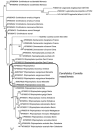Candidatus Coxiella massiliensis Infection
- PMID: 26811945
- PMCID: PMC4734529
- DOI: 10.3201/eid2202.150106
Candidatus Coxiella massiliensis Infection
Abstract
Bacteria genetically related to Coxiella burnetii have been found in ticks. Using molecular techniques, we detected Coxiella-like bacteria, here named Candidatus Coxiella massiliensis, in skin biopsy samples and ticks removed from patients with an eschar. This organism may be a common agent of scalp eschar and neck lymphadenopathy after tick bite.
Keywords: Candidatus Coxiella massiliensis; Coxiella-like bacteria; SENLAT; bacteria; eschar; parasites; scalp eschar and neck lymphadenopathy after tick bite; skin biopsy; ticks; vector-borne infections; vectorborne.
Figures


Similar articles
-
The Importance of Ticks in Q Fever Transmission: What Has (and Has Not) Been Demonstrated?Trends Parasitol. 2015 Nov;31(11):536-552. doi: 10.1016/j.pt.2015.06.014. Epub 2015 Oct 11. Trends Parasitol. 2015. PMID: 26458781 Review.
-
Coxiella-like bacteria in fowl ticks from Thailand.Parasit Vectors. 2018 Dec 27;11(1):670. doi: 10.1186/s13071-018-3259-9. Parasit Vectors. 2018. PMID: 30587229 Free PMC article.
-
Coxiella-like endosymbionts.Adv Exp Med Biol. 2012;984:365-79. doi: 10.1007/978-94-007-4315-1_18. Adv Exp Med Biol. 2012. PMID: 22711641 Review.
-
Scalp eschar and neck lymphadenopathy caused by Bartonella henselae after Tick Bite.Clin Infect Dis. 2010 Feb 15;50(4):549-51. doi: 10.1086/650172. Clin Infect Dis. 2010. PMID: 20070235
-
Scalp eschar and neck lymphadenopathy after tick bite: an emerging syndrome with multiple causes.Eur J Clin Microbiol Infect Dis. 2014 Aug;33(8):1449-56. doi: 10.1007/s10096-014-2090-2. Epub 2014 Mar 29. Eur J Clin Microbiol Infect Dis. 2014. PMID: 24682865
Cited by
-
Cross-alteration of murine skin and tick microbiome concomitant with pathogen transmission after Ixodes ricinus bite.Microbiome. 2023 Nov 11;11(1):250. doi: 10.1186/s40168-023-01696-7. Microbiome. 2023. PMID: 37952001 Free PMC article.
-
The Prevalence of Coxiella burnetii in Hard Ticks in Europe and Their Role in Q Fever Transmission Revisited-A Systematic Review.Front Vet Sci. 2021 Apr 26;8:655715. doi: 10.3389/fvets.2021.655715. eCollection 2021. Front Vet Sci. 2021. PMID: 33981744 Free PMC article.
-
From Q Fever to Coxiella burnetii Infection: a Paradigm Change.Clin Microbiol Rev. 2017 Jan;30(1):115-190. doi: 10.1128/CMR.00045-16. Clin Microbiol Rev. 2017. PMID: 27856520 Free PMC article. Review.
-
Coxiella burnetii and Related Tick Endosymbionts Evolved from Pathogenic Ancestors.Genome Biol Evol. 2021 Jul 6;13(7):evab108. doi: 10.1093/gbe/evab108. Genome Biol Evol. 2021. PMID: 34009306 Free PMC article.
-
Recent insights into the tick microbiome gained through next-generation sequencing.Parasit Vectors. 2018 Jan 4;11(1):12. doi: 10.1186/s13071-017-2550-5. Parasit Vectors. 2018. PMID: 29301588 Free PMC article. Review.
References
MeSH terms
LinkOut - more resources
Full Text Sources
Other Literature Sources

